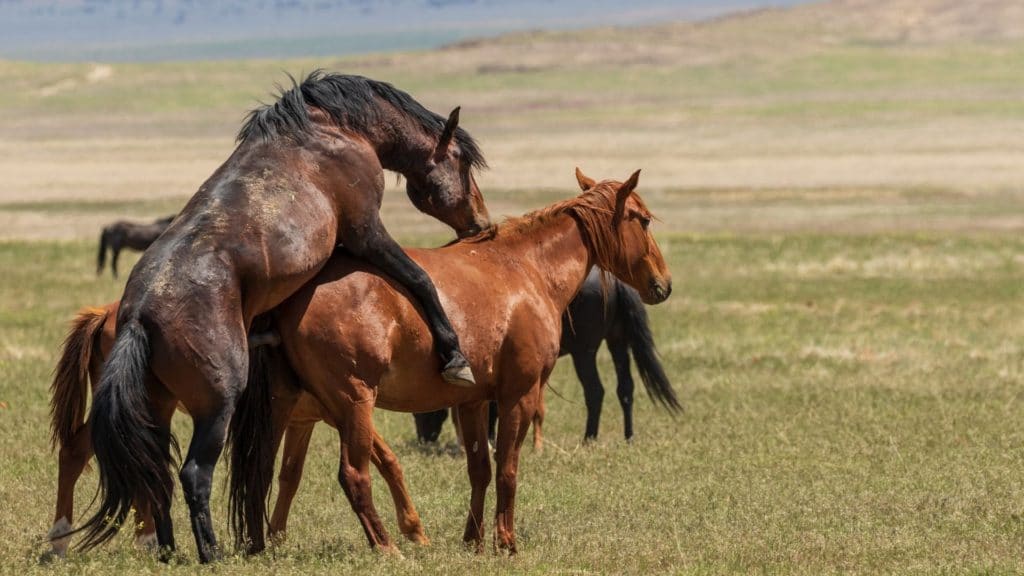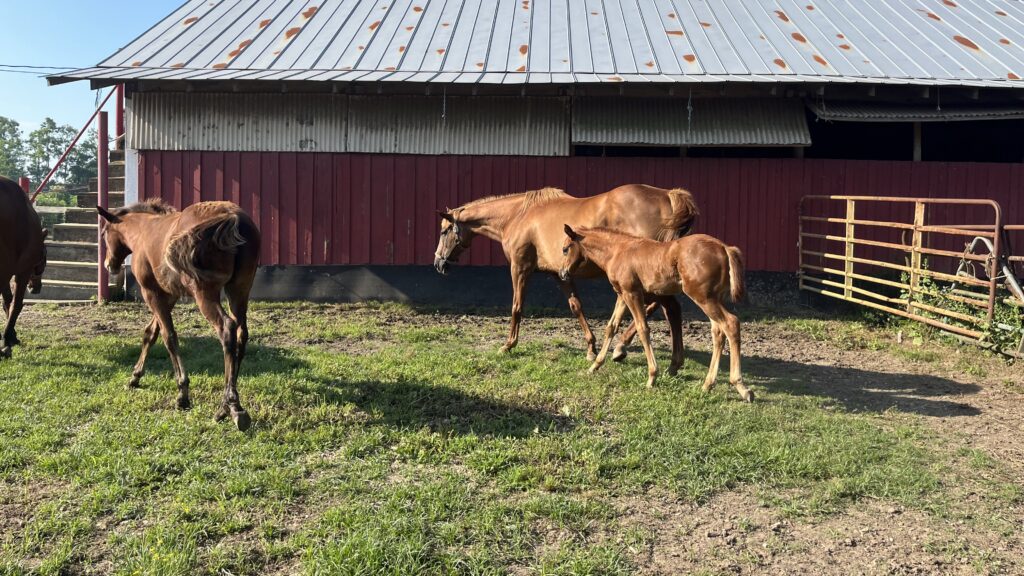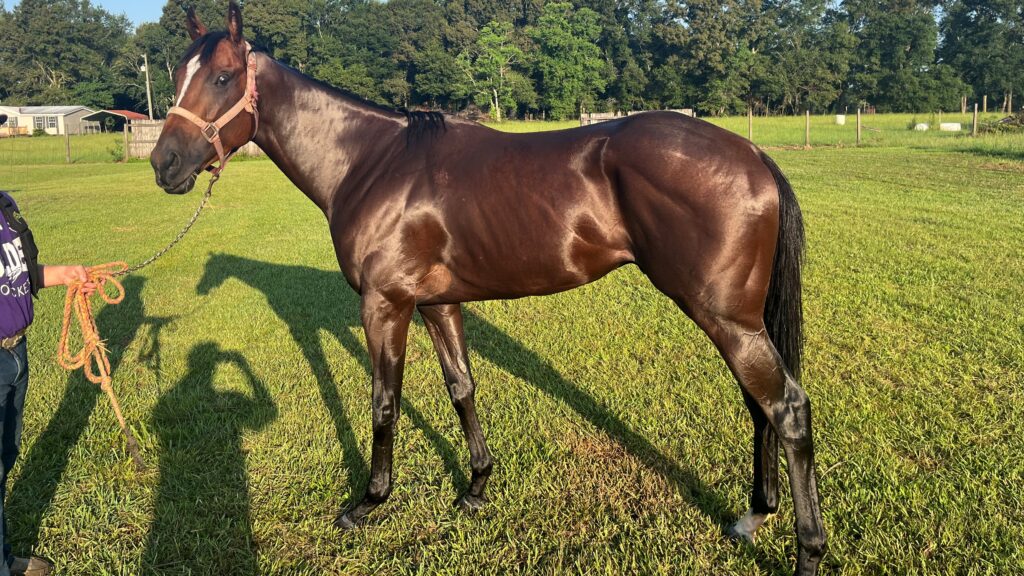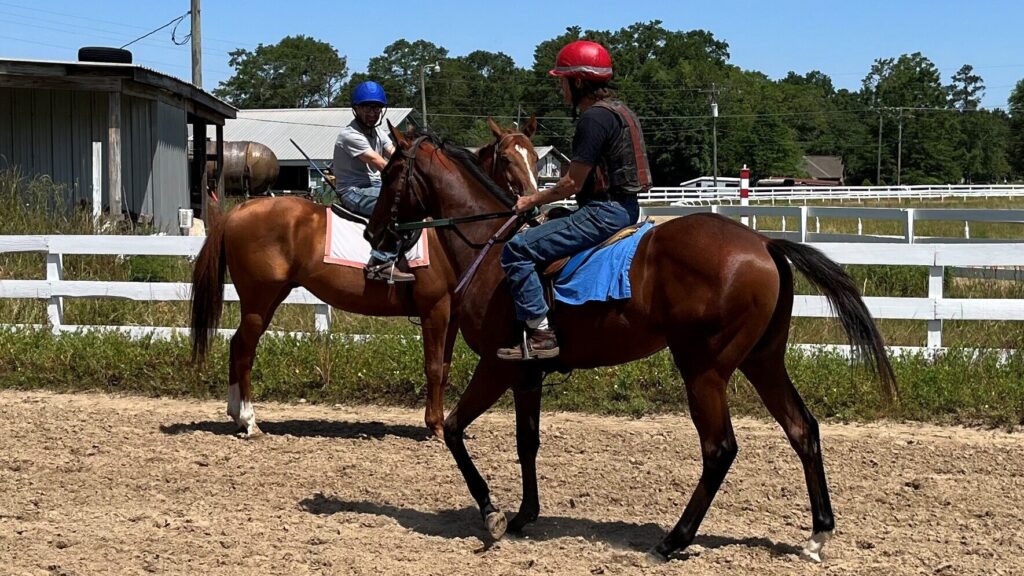Last updated: March 7, 2025
Ever wondered why Thoroughbred racing treasures the age-old practice of live cover breeding? As a dedicated racehorse owner, I’ve delved into the heart of our sport’s traditions and discovered that it’s not just about preserving the past.
The Jockey Club’s steadfast commitment to “live cover” breeding safeguards genetic diversity, upholds the industry’s economic integrity, and navigates complex legal landscapes, ensuring the Thoroughbred legacy thrives. Join me as we explore the fascinating reasons behind this choice, revealing how it shapes the future of racing.

The Essence of “Live Cover” in Thoroughbred Breeding
In Thoroughbred breeding, the tradition of “live cover” stands as a testament to the industry’s dedication to preserving the breed’s integrity and heritage. This age-old practice, where a stallion physically mates with a mare, marries centuries of history with a profound respect for the balance between tradition and science.
Why Live Cover?
The Jockey Club, which governs Thoroughbred breeding, champions live cover for its ability to maintain genetic diversity, uphold economic and legal standards, and honor the rich traditions of the racing world.
This method ensures a broad representation of stallions contribute to the gene pool, safeguarding against the dominance of a few bloodlines that artificial insemination might promote.
Tradition and Heritage
Live cover is deeply rooted in the history of Thoroughbred racing, connecting us to the sport’s evolution and reminding us of the journey from past to present. It’s a practice that not only honors the legacy of horse racing but also ensures the continuation of its storied traditions.
Genetic Diversity
The Jockey Club’s insistence on live cover aims to protect the Thoroughbred’s genetic diversity, ensuring a wide array of stallions have the opportunity to pass on their traits. This commitment helps prevent the narrowing of genetic lines, a risk associated with the selective use of stallions in artificial insemination practices.
Economic and Legal Considerations
Choosing live cover impacts more than just breeding practices; it influences the Thoroughbred industry’s economic landscape and navigates complex legal frameworks.
By valuing live cover, the industry supports a diverse ecosystem of breeding farms and related services while also sidestepping the regulatory challenges that artificial insemination could introduce.
A Commitment to Excellence
This steadfast adherence to live cover reflects a broader dedication to excellence within Thoroughbred breeding. It’s a practice that looks back with reverence, stands firm in the present, and plans for a future where the legacy of Thoroughbred racing thrives on integrity, diversity, and quality.

AI vs. Live Cover: Exploring the Differences
As we delve into the broader world of horse breeding, it’s clear that each breed’s story is shaped by its chosen breeding methods. While breeds like Quarter Horses and Standardbreds often embrace artificial insemination (AI) to enhance genetic diversity and accessibility, Thoroughbreds remain loyal to live cover, highlighting a divergence in economic and genetic strategies.
Quarter Horses & Standardbreds
These breeds leverage AI to broaden their genetic horizons and make breeding more accessible. This approach starkly contrasts with Thoroughbred traditions, underscoring the unique economic and genetic ambitions within different segments of the equine industry.
Impact on Market Dynamics
AI’s role in expanding the genetic pool introduces a new economic model to horse breeding, contrasting with the Thoroughbred industry’s preference for live cover, which maintains market exclusivity and value.
Advantages of AI in Broader Equine Breeding
Celebrated for its safety, precision in genetic management, and convenience, AI offers a way to disseminate desirable traits widely and manage genetic health across breeds. It represents a critical tool in the evolution of horse breeding, providing options that live cover does not.
Why Live Cover Holds Sway in Thoroughbreds
Despite AI’s benefits, the Thoroughbred industry’s preference for live cover is a deliberate choice to uphold the breed’s legacy and ensure genetic purity. Advocates argue that live cover promotes a more natural selection process, enhancing the breed’s strength and vitality.

The Role of the Jockey Club in Thoroughbred Breeding
The Jockey Club plays a pivotal role in shaping the Thoroughbred racing world. Here’s an insight into its influence and regulations:
- Establishment and Function:
- Founded in 1750, the Jockey Club is a central authority in horse racing.
- It regulates Thoroughbred breeding and racing, ensuring the sport’s integrity.
- Mandates for Breeding:
- Stipulates that all Thoroughbreds must be conceived via “live cover.”
- Prohibits the use of artificial insemination and embryo transfer.
Rationale Behind the Rules
- Preservation of Tradition and Quality:
- Aims to preserve genetic purity and historical breeding methods.
- Believes traditional breeding contributes to the breed’s strength and resilience.
- Controls breeding to maintain the high value and quality of the racehorse market.
Below is a YouTube video showing the teasing process before horse mating.
Introduction to the Science Behind Live Cover
The practice of “live cover” in Thoroughbred breeding is not just a tradition but also a scientifically backed method with significant genetic implications. Understanding these nuances helps us appreciate why this method is preferred in the Thoroughbred racing world.
Genetic Implications of Live Cover Versus Artificial Insemination
- Natural Selection Process:
- Live cover allows for natural selection, ensuring only the fittest and most adaptable traits are passed on.
- Artificial insemination could lead to a wider genetic pool but may dilute certain desirable traits specific to Thoroughbreds.
Contribution of Live Cover to Genetic Diversity and Horse Health
- Maintaining Genetic Health:
- Live cover ensures a controlled yet diverse genetic makeup, essential for the overall health of the breed.
- It reduces the risk of widespread genetic disorders that could arise from overuse of a limited number of stallions in artificial insemination.
Insights from Equine Geneticists and Breeders
- Expert Opinions:
- Geneticists emphasize the importance of genetic diversity for disease resistance and overall vitality.
- Experienced breeders often note the robustness and resilience of foals conceived through live cover.
The science behind “live cover” underscores its importance in maintaining the integrity and health of Thoroughbreds. By blending tradition with scientific principles, this breeding method continues to be the cornerstone of producing elite racehorses, as echoed by experts in the field.

FAQs for “Do Thoroughbred Stallions Live Cover a Mare?”
What is ‘live cover’ in Thoroughbred breeding?
‘Live cover’ is the natural breeding process where a stallion physically mates with a mare, without artificial insemination, to preserve genetic integrity in Thoroughbreds.
Why is live cover required for Thoroughbred breeding?
Live cover maintains genetic diversity and lineage purity, following traditional breeding practices upheld by The Jockey Club.
Can Thoroughbreds be bred using artificial insemination?
No, The Jockey Club’s regulations prohibit registering Thoroughbreds bred through artificial insemination to preserve traditional breeding methods.
Does live cover affect Thoroughbred horse health?
Live cover ensures controlled genetic diversity, crucial for overall breed health and reducing genetic disorders.

Steps for Registering Your Thoroughbred Foal.
Start by visiting the registration information webpage for the Jockey Club. They provide detailed information on the registration process. This section is an overview of the steps required.
- Step 1: The Jockey Club maintains a Report of Mares Bred (RMB) database for each stud. All owners of stallions must report mares bred to the stallion during the year and include the date of her last cover.
- Step 2: Within 30 days of birth, someone, either the owner, breeder, or agent, must complete a Live Foal/No Foal Report. You can click this link to read the instructions.
- Step 3: A registration application and genetic typing kit will be sent to the address listed on the Live Foal Report. The form must be completed and returned with four-color photos. A sample of the foal’s mane or tail must be mailed directly to the DNA laboratory listed. Instructions can be found here.
Conclusion
In exploring the nuanced practices of live cover horse breeding within the Thoroughbred industry, we’ve delved into the rich tapestry of tradition, the critical importance of genetic diversity, and the intricate economic and legal frameworks that shape this age-old practice.
Live cover breeding, as championed by The Jockey Club, not only honors the storied heritage of Thoroughbred racing but also ensures the breed’s integrity and quality for future generations.
This commitment to excellence, rooted in a deep understanding of the balance between tradition and science, underscores the Thoroughbred industry’s dedication to preserving the legacy of these magnificent animals.
Authorities on Live Cover Breeding: Further Reading and Insights
For those interested in a deeper exploration of the topics discussed, the following authoritative sources offer comprehensive insights and research findings on live cover breeding.
Sustainability in Thoroughbred Breeding
- “Sustainability and the Thoroughbred Breeding and Racing Industries: An Enhanced One Welfare Perspective” by Stallones, L., McManus, P., & McGreevy, P. (2023). This article tackles the global challenges faced by Thoroughbred breeding and racing, aiming for sustainability through the “Enhanced One Welfare Framework.” Read the full article on PubMed Central
Economic Contributions and State Programs
- “The Kentucky Thoroughbred Breeding Industry And State Programs That Assist The Equine Industry” by the Legislature of Kentucky. This report highlights the significant economic contributions of the Thoroughbred breeding industry in Kentucky and provides insights into state programs supporting the equine industry. Access the report here.
Live Cover vs. Artificial Insemination
- “Live Cover vs. Artificial Insemination in Thoroughbred Breeding” on BloodHorse Blog. Delve into The Jockey Club’s stance on live cover breeding and its reasons for prohibiting artificial insemination, including discussions on tradition, genetic diversity, and economic implications. Explore the discussion on BloodHorse
Scientific Comparative Studies
- “Effect of Natural Mating and Artificial Insemination with Frozen Semen on the Duration of the Service Period in Mares” in IOP Science. This study examines the effectiveness of natural mating and artificial insemination in horse breeding, offering insights into pregnancy rates and management practices. Study details on IOP Science
- “Factors Influencing the Popularity of Artificial Insemination of Mares in Europe.” published in PubMed Central. This research highlights the shift towards artificial insemination in European horse breeding, emphasizing the role of semen quality and storage technology.
Call to Action
As we conclude our exploration into the captivating world of Thoroughbred breeding, I encourage you, the readers, to become active participants in this ongoing dialogue. Whether you’re a seasoned breeder, a horse racing enthusiast, or simply someone fascinated by these magnificent creatures, your voice and perspective are valuable.
Engage and Share: If this article sparked new ideas or reinforced your passion, share it with your network. Discuss it with peers, post it on social media, or bring it up in community forums. The more we share, the richer our collective understanding becomes.
Stay Informed: Continue to educate yourself. Utilize the resources listed, join forums, and attend industry events. Knowledge is a powerful tool in any field, especially one as dynamic as Thoroughbred breeding.
Voice Your Opinions: Your experiences, insights, and opinions matter. Participate in surveys, write to industry publications, or engage in online discussions. Your unique perspective can contribute significantly to the future of Thoroughbred breeding.
Here is the diagram illustrating the key aspects of live cover horse breeding in Thoroughbreds:
Additional Resources
Here are more resources you can use to dive deeper into the world of horse breeding and the nuances of equine care:
Books and Publications
- “The First Scientific Principles of Thoroughbred Breeding, “ Parts 1 and 2, by Harold Hampton – Offers an in-depth look at the basic principles of breeding racehorses.
- “Thoroughbred Breeding: Pedigree Theories and the Science of Genetics” by Matthew Binns and Tony Morris – A comprehensive guide combining traditional pedigree theories with modern genetic research.
Academic Journals
- Equine Veterinary Journal: Access studies and papers on equine health and genetics, crucial for understanding breeding impacts.
- Journal of Animal Science: Find research articles focusing on animal breeding, genetics, and bioethics.
Interactive Online Platforms
- Equibase: www.equibase.com – Provides detailed statistics and histories of racehorses, invaluable for breeders and enthusiasts.
- Thoroughbred Heritage: www.tbheritage.com – A resource for historical information on Thoroughbred bloodlines and breeding.
Related articles:
- Thoroughbred Horse Breed: Facts and Characteristics
- Retired Racehorse Adoption Guide: All You Need to Know
- 12 Horse Coat Colors: Patterns, Genetics, and Pictures
- Do Thoroughbreds Have Bad Feet? 5 Traits of poor horse hoofs
- Registered Thoroughbred Horses: What Colors Are Permitted?
- Why are Racehorse Names so Weird? 15 Funny Examples!

About the Author: Miles Henry
Lifelong Horseman | Racehorse Owner | Published Author
Miles Henry brings over 25 years of hands-on experience training and owning Thoroughbred racehorses. Raised with Quarter Horses and Appaloosas, he’s spent a lifetime learning from horses—on the track, in the barn, and in the field. Today, he runs a small but successful racing stable in Louisiana and shares real-world insights on HorseRacingSense.com, helping horse owners, fans, and bettors navigate the sport with confidence.
📚 Books: View Miles’s books on Amazon »
🎧 Podcast Guest: Animal Tales Ep. 32 |
YouTube Interview
📩 Newsletter: Sign up for racing tips and horse care advice »
🔗 Follow Miles:
Twitter |
Facebook |
YouTube


